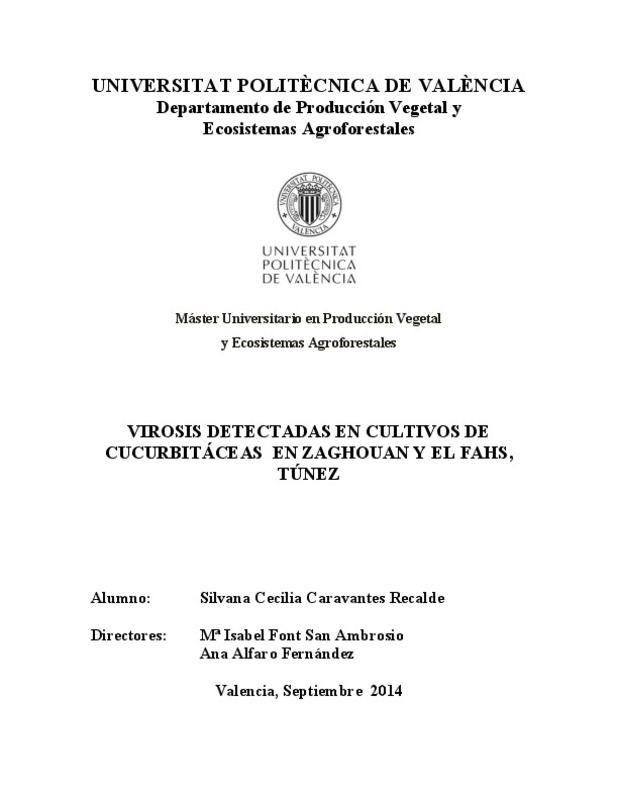JavaScript is disabled for your browser. Some features of this site may not work without it.
Buscar en RiuNet
Listar
Mi cuenta
Estadísticas
Ayuda RiuNet
Admin. UPV
Virosis detectadas en cultivos de cucurbitáceas en Zaghouan y El Fahs, Túnez
Mostrar el registro sencillo del ítem
Ficheros en el ítem
| dc.contributor.advisor | Font San Ambrosio, Maria Isabel
|
es_ES |
| dc.contributor.advisor | Alfaro Fernández, Ana Olvido
|
es_ES |
| dc.contributor.author | Caravantes Recalde, Silvana Cecilia
|
es_ES |
| dc.date.accessioned | 2015-03-10T12:53:25Z | |
| dc.date.available | 2015-03-10T12:53:25Z | |
| dc.date.created | 2014-09-24 | |
| dc.date.issued | 2015-03-10 | |
| dc.identifier.uri | http://hdl.handle.net/10251/47927 | |
| dc.description.abstract | [EN] Family Cucurbitaceae includes important crops worldwide; among them it can be mentioned watermelon (Citrullus lanatus), melon (Cucumis melo), cucumber (Cucumis sativus), zucchini (Cucurbita pepo) and pumpkin (Cucurbita maxima and C. moschata). In Tunisia, cucurbit production have increased significantly over the past few years, but lately it has been found cucurbit plants with symptoms of different viral diseases which reduce the yield and quality of crops, making some products unmarketable. In 2013, symptomatic cucurbit plants were observed in Zhagouan and El Fahs. Atotal of 18 leaves samples were collected in 2013 in six different fields (three in each area). Samples were analyzed by molecular (PCR and RT-PCR) and serological methods (DAS – ELISA). The analysis included viruses that typically affect cucurbits in the Mediterranean area, such as: Papaya ring spot virus (PRSV), Watermelon mosaic virus (WMV), Zucchini yellow fleck virus (ZYFV), Zucchini yellow mosaic virus (ZYMV), Moroccan watermelon mosaic virus (MWMV), Cucumber vein yellowing virus (CVYV), Beet yellows virus (BYV), Beet pseudoyellows virus (BPYV), Cucumber yellow stunting disorder virus (CYSDV), Tomato spotted wilt virus (TSWV), Cucumber green mottle mosaic virus (CGMMV), Cucumber mosaic virus (CMV), Cucumber leaf spot virus (CLSV), Melon necrotic spot virus (MNSV), Squash mosaic virus (SqMV), Cucumber aphidborne yellows virus (CABYV) and Tomato leaf curl Nueva Delhi virus (ToLCNDV). Tomato yellow leaf curl Sardinia virus (TYLCSV)y Tomato yellow leaf curl virus (TYLCV) were also analyzed because they have been recently reported affecting watermelon in Tunisia.. From the eighteen samples analyzed from the regions of Zaghouan and El Fahs, one and five were positive to CABYV for melon and cucumber, respectively. CMV type 1A was also detected in three cucumber samples collected in El Fahs, which were also infected with CABYV. All the other viruses tested were not detected in these regions | es_ES |
| dc.description.abstract | [ES] Las cucurbitáceas son una familia de plantas que incluyen diversos cultivos de gran importancia a nivel mundial, entre ellos se puede nombrar a la sandía (Citrullus lanatus), el melón (Cucumis melo), el pepino (Cucumis sativus), el calabacín (Cucurbita pepo) y la calabaza (Cucurbita maxima y C. moschata). En Túnez la producción de cultivos de cucurbitáceas ha ido aumentando significativamente con los años, detectándose un aumento de enfermedades de etiología viral en estos cultivos; reduciendo los rendimientos y la calidad de los cosechas, ocasionando pérdidas económicas al generar productos no comerciales. En el año 2013, en la zona norte de Túnez, concretamente en Zaghouan y El Fahs se observó en diferentes cultivos de cucurbitáceas un incremento de plantas con síntomas de enfermedades virales. Se tomaron muestras de dieciocho plantas sintomáticas de seis parcelas (tres de cada zona) y se analizaron mediante técnicas moleculares (PCR y RT-PCR) y serológicas (DAS – ELISA). Los análisis incluyeron los principales virus que afectan a las cucurbitáceas en el área mediterránea, entre ellos: Papaya ring spot virus (PRSV), Watermelon mosaic virus (WMV), Zucchini yellow fleck virus (ZYFV), Zucchini yellow mosaic virus (ZYMV), Moroccan watermelon mosaic virus (MWMV), Cucumber vein yellowing virus (CVYV), Beet yellows virus (BYV), Beet pseudoyellows virus (BPYV), Cucumber yellow stunting disorder virus (CYSDV), Tomato spotted wilt virus (TSWV), Cucumber green mottle mosaic virus (CGMMV), Cucumber mosaic virus (CMV), Cucumber leaf spot virus (CLSV), Melon necrotic spot virus (MNSV), Squash mosaic virus (SqMV), Cucumber aphid-borne yellows virus (CABYV) y Tomate leaf curl Nueva Delhi virus (ToLCNDV). Se incluyeron además análisis para determinar la presencia de Tomato yellow leaf curl Sardinia virus (TYLCSV) y Tomato yellow leaf curl virus (TYLCV), recientemente detectados en cultivos de sandía de Túnez. En este estudio se detectó CABYV en una muestra de melón en Zaghouan y en cinco de pepino de El Fahs. Tres de las muestras de pepino infectadas con CABYV estaban coinfectadas con CMV del tipo 1A. En las demás muestras no pudo detectar ningún otro virus de los analizados en el presente trabajo | es_ES |
| dc.format.extent | 68 | es_ES |
| dc.language | Español | es_ES |
| dc.publisher | Universitat Politècnica de València | es_ES |
| dc.rights | Reconocimiento - No comercial - Sin obra derivada (by-nc-nd) | es_ES |
| dc.subject | DAS-ELISA | es_ES |
| dc.subject | RT-PCR | es_ES |
| dc.subject | PCR | es_ES |
| dc.subject | Diagnóstico | es_ES |
| dc.subject | Virus vegetales | es_ES |
| dc.subject | Diagnostic | es_ES |
| dc.subject | Plant virus | es_ES |
| dc.subject.classification | PRODUCCION VEGETAL | es_ES |
| dc.subject.other | Máster Universitario en Producción Vegetal y Ecosistemas Agroforestales-Màster Universitari en Producció Vegetal i Ecosistemes Agroforestals | es_ES |
| dc.title | Virosis detectadas en cultivos de cucurbitáceas en Zaghouan y El Fahs, Túnez | es_ES |
| dc.type | Tesis de máster | es_ES |
| dc.rights.accessRights | Abierto | es_ES |
| dc.contributor.affiliation | Universitat Politècnica de València. Servicio de Alumnado - Servei d'Alumnat | es_ES |
| dc.description.bibliographicCitation | Caravantes Recalde, SC. (2014). Virosis detectadas en cultivos de cucurbitáceas en Zaghouan y El Fahs, Túnez. http://hdl.handle.net/10251/47927 | es_ES |
| dc.description.accrualMethod | Archivo delegado | es_ES |






